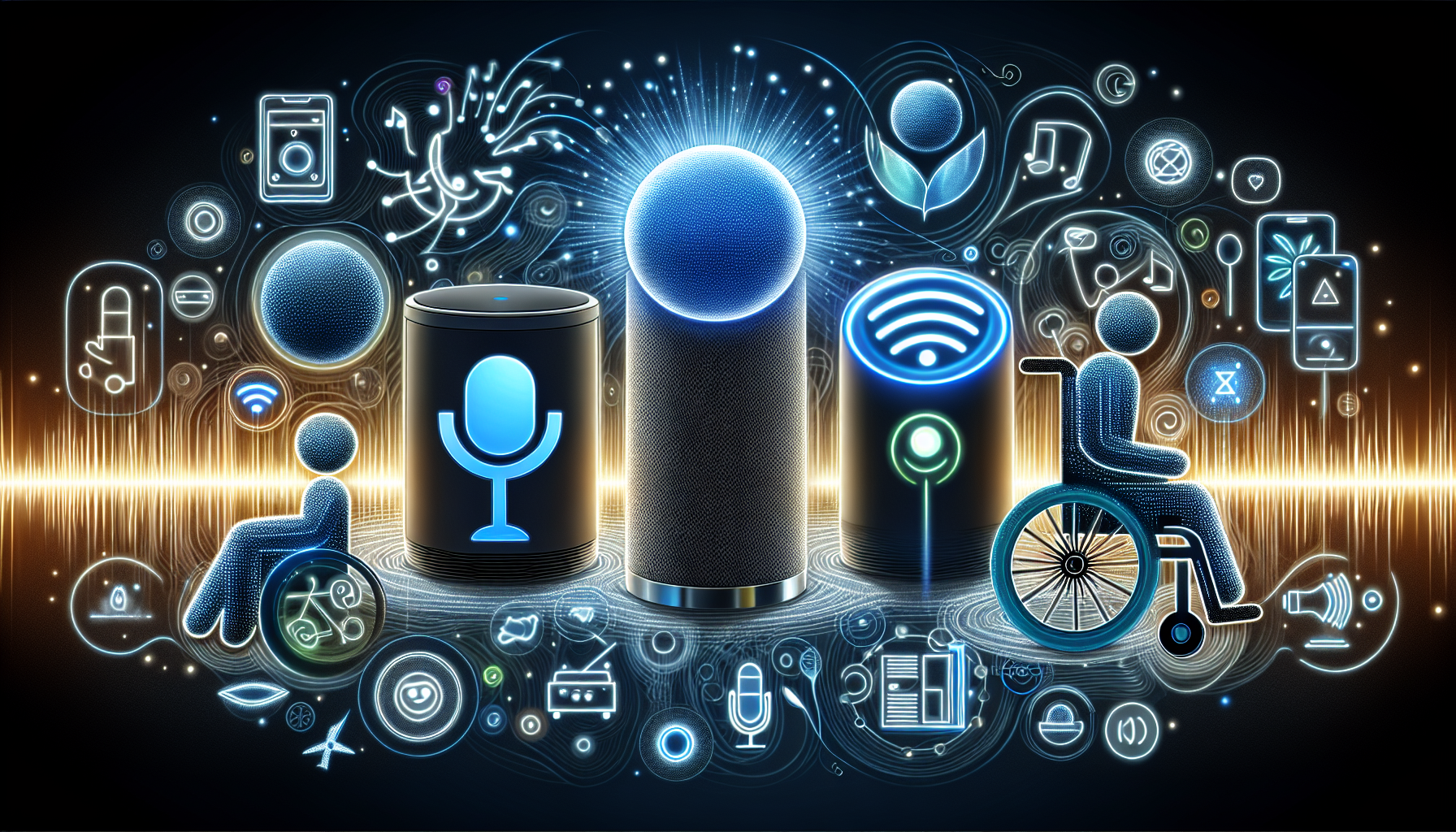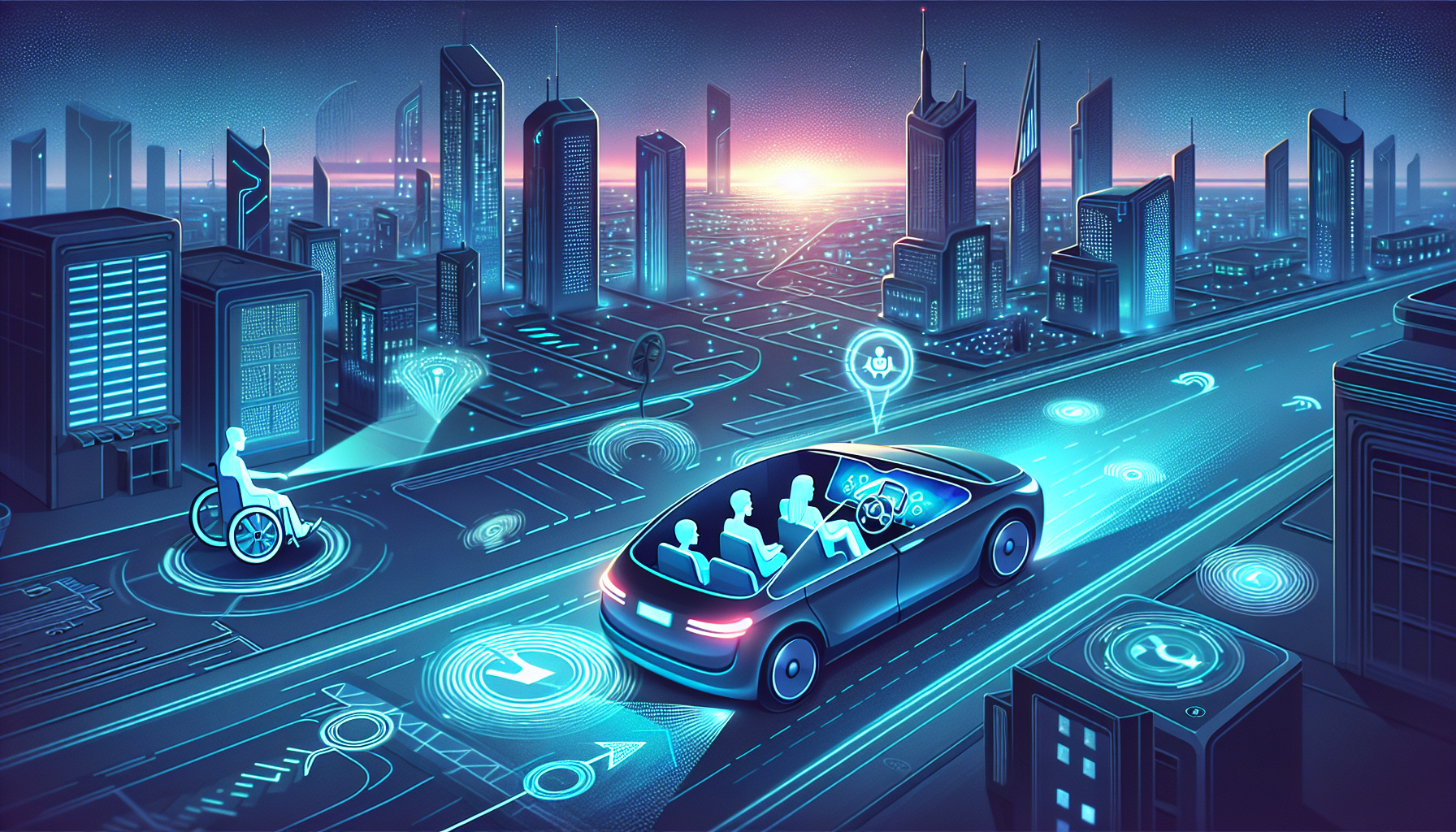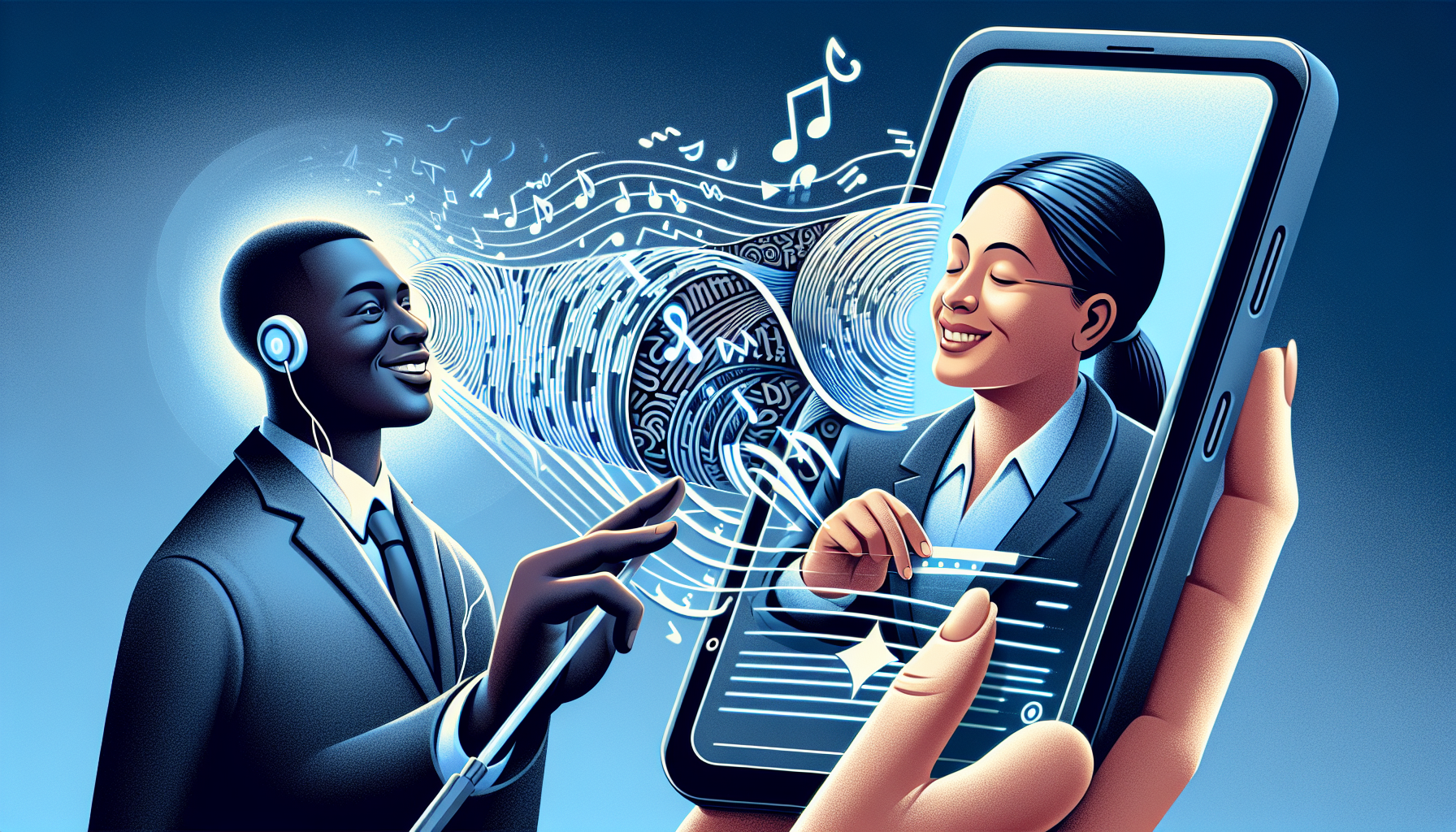Paul
Jul 28, 2024
Table of Contents |
How do AI voices for accessibility assist people with disabilities? AI voices for accessibility assist people with disabilities enhance communication, support independent living, and provide information access. This article dives into the ways AI voice tools are transforming lives, making daily tasks easier, and breaking down barriers.
Key Takeaways
- AI voice tools, like Google Live Transcribe and Voiceitt, significantly enhance communication for people with speech and hearing impairments by providing real-time transcriptions and voice command functionalities.
- AI-powered voice control technologies, such as Amazon Alexa, empower individuals with limited mobility to live more independently by enabling hands-free control over their home environment and digital interactions.
- Text-to-speech tools and innovative applications like Lookout by Google and Seeing AI by Microsoft improve access to information and enhance the confidence and autonomy of visually impaired users by vocalizing text and describing their surroundings.
The Role of AI Voice Tools in Accessibility

AI voice tools are lifelines for individuals grappling with accessibility issues, not just technological marvels. They significantly enhance the life quality of people with disabilities by improving communication, fostering independent living, and ensuring smooth access to information.
A profound understanding of their impact necessitates a deeper exploration of each of these aspects.
Improving Communication through AI Voice Tools
AI voice tools bridge the gap, especially for individuals with speech impairments, as communication is a fundamental human need. AI-based live transcription tools, such as Google Live Transcribe, transcribe speech in real-time, making conversations more accessible for people with hearing impairments. These advancements foster greater inclusion, allowing everyone to participate fully in social and professional settings.
Voice-controlled interfaces and speech recognition technologies enable applications like automated transcriptions and voice assistants, enhancing communication for those with speech disabilities. For example, Ava is an app that helps people with hearing impairments follow group conversations without the need for lip-reading. Similarly, Voiceitt supports dictation for emails and other text-based communication, making digital interactions more seamless.
Moreover, Voiceitt’s integration with WebEx has made video calls more inclusive by incorporating innovative AI captioning and transcription. These tools not only assist individuals with speech impairments but also benefit accented speakers by accurately interpreting diverse speech patterns. Through these AI technologies, communication barriers are being dismantled, one voice at a time.
Google Live Transcribe 🔊This Android app provides real-time transcription of speech into text in over 70 languages, enhancing accessibility for the deaf and hard of hearing. It uses Google's advanced speech recognition technology to make conversations more inclusive. |
Ava 📝Ava offers real-time captions and transcriptions powered by AI, making group conversations more accessible for individuals with hearing impairments. The app is particularly useful in professional and social settings. |
Voiceitt 🗣️Voiceitt develops voice recognition technology that helps individuals with speech impairments communicate more clearly. The technology interprets atypical speech patterns, supporting users in everyday digital interactions and voice-controlled systems. |
Independent Living with AI Voice Control
AI-powered voice control technologies have been a game-changer, particularly for individuals with limited mobility, enabling a hitherto unimaginable level of independence. Virtual assistants like Amazon’s Alexa allow users to control their home environment with simple voice commands, transforming how people with disabilities manage their daily lives.
Smart speakers linked to home automation systems empower users to turn on lights, adjust thermostats, or even open curtains without lifting a finger. This hands-free control is particularly beneficial for those with motor impairments, significantly enhancing their quality of life.
Voice command technology also extends to navigating websites and completing online tasks, providing a seamless digital experience for people with disabilities. Users can automate multiple actions with a single voice command by setting up custom routines or’ applets, making everyday activities more manageable.
These innovations are not just about convenience; they are about empowering individuals to live independently and with dignity.
Virtual Assistants 🎙️Amazon Alexa: Enables control of home environments through voice commands, allowing users to manage lights, thermostats, and other devices hands-free. |
Smart Speakers 🏠Linked to Home Automation Systems: Provide the ability to control various home appliances, such as lights and curtains, enhancing convenience and accessibility for those with limited mobility. |
Voice Command Technologies 🌐Website Navigation and Online Tasks: Facilitate easier access to digital content and online services, making it possible to complete tasks with voice commands instead of traditional inputs. |
Custom Routines and Applets 🔄Automated Actions: Users can set up sequences of actions triggered by specific voice commands, simplifying daily routines and enhancing efficiency. |
Access to Information with Text-To-Speech
AI-driven text-to-speech technologies have made access to information, a critical component of independence, a reality for visually impaired users. By interpreting and vocalizing text on screens, these tools provide individuals with visual impairments the same access to written content as their sighted peers.
AI-powered tools can enhance website accessibility for visually impaired people in several ways:
Screen Readers & Text-to-Speech 📄Screen readers and text-to-speech software vocalize text, making digital content accessible. |
AI-Generated Alt Text 🖼️AI can automatically generate alt text descriptions for images and videos. |
GIPHY & Digital Accessibility 🌟GIPHY’s partnership with a digital accessibility provider has resulted in alt text descriptions for popular GIFs, improving the user experience for blind users. |
Lookout & Seeing AI 📱Innovative tools like Lookout by Google and Seeing AI by Microsoft take accessibility a step further by using a phone’s camera to narrate the surroundings in real-time. These applications can:
|
Such technologies are changing how individuals with visual impairment navigate their environments, providing them with a greater sense of autonomy and confidence.
AI Tools: Enhancing Mobility

AI and Accessibility in Mobility
Artificial intelligence tools are stepping in to enhance mobility, a significant life aspect that presents a challenge for many individuals with disabilities. Accessible navigation apps and autonomous vehicles are offering unprecedented levels of freedom and spontaneity.
- Google Maps: Offers a ‘wheelchair accessible’ option and features that highlight accessible public venues.
- Moovit: Provides real-time traffic information.
- Wheelmap: Lists and maps accessible locations.
These tools make public spaces more navigable and inclusive for individuals with limited mobility.
Autonomous Vehicles
Autonomous vehicles present another leap forward in mobility solutions. In places like Grand Rapids, autonomous vans operated by May Mobility offer an alternative to public transportation, especially benefiting those with physical disabilities. These vehicles are equipped with:
- Cameras
- Radar
- GPS
- Laser sensors
This provides reliable service even in challenging weather conditions.
Projects like goMARTI in Minnesota demonstrate the potential of self-driving vehicles to provide safe and accessible transportation. Users can arrange rides via a smartphone app or a social service telephone line, offering a flexible and user-friendly experience. These advancements enhance mobility and promote greater inclusion and participation in society for people with disabilities.
goMARTI Project
The goMARTI project in Grand Rapids, MN, offers free, autonomous shuttle services, enhancing mobility for those with disabilities. The shuttles are equipped with advanced technology, including cameras and GPS, ensuring safe and reliable transport. The project aims to improve accessibility and test the viability of autonomous vehicles in rural and challenging weather conditions.
Customizable AI Solutions

Addressing the unique needs of individuals with non standard speech and atypical speech patterns necessitates customizable AI solutions. Voiceitt, an Augmentative and Alternative Communication (AAC) and Assistive Technology (AT) tool, exemplifies this personalized approach.
Voiceitt’s technology is adaptive, learning the speech patterns of individual users to improve communication over time. The tool includes three key modes: Speak for speech-to-speech interaction, Dictate for speech-to-text, and Integrations for interacting with smart home systems. This versatility makes it a powerful tool for enhancing daily communication and automation tasks, utilizing voice recognition technology and harnessing the potential of voice technology.
To ensure accuracy and effectiveness, Voiceitt requires users to teach it their unique speech patterns by recording specific phrases, which serve as speech samples. This personalized approach not only improves the tool’s performance but also empowers users to communicate more efficiently and independently. By combining machine learning techniques with a proprietary database of atypical speech patterns, Voiceitt is making significant strides in inclusivity.
Voiceitt
Customizable AI 🗣️Adapts to users' unique speech patterns for better communication. |
Key Modes 🔊Speak, Dictate, and Integrations for versatile use. |
Personal Training 📊Users train the system with specific phrases. |
Inclusive Technology 🔍Promotes inclusivity with machine learning and a speech pattern database. |
Real-World Applications and Success Stories
The transformative potential of AI voice tools is highlighted by their real-world applications. Voiceitt’s integration with platforms like WebEx and Microsoft Teams is a prime example, providing personalized closed captioning to create more inclusive work environments. Voiceitt has also helped stroke survivors communicate with smart home systems, showcasing its versatility and impact on everyday life. The company’s ability to raise $10M underscores the importance of funding in advancing AI technology for accessibility.
Amazon’s efforts to highlight accessibility features in its products, such as Alexa, Fire TV, and Kindle, further demonstrate the commitment to inclusivity. The company has produced new videos to showcase how people with disabilities can benefit from these features, making technology more accessible to all.
Voiceitt 🔊Provides personalized closed captioning and smart home integration, enhancing accessibility and communication for individuals with atypical speech patterns. |
WebEx & Microsoft Teams 💻Integrated with Voiceitt to offer personalized closed captioning for more inclusive virtual meetings. |
Amazon 🏠Highlighted accessibility features in Alexa, Fire TV, and Kindle, showcasing technology’s role in supporting people with disabilities. |
Challenges and Future Directions
Delays & Accuracy ⏳Issues with delays and accuracy in captions affect those with hearing impairments. |
Bias in AI ⚖️Bias in AI systems can exclude individuals with atypical speech patterns. |
Inconsistent Performance 🎨Inaccurate color recognition and other inconsistencies interfere with accessibility. |
Inclusive Data Collection 📊Underrepresentation in datasets can lead to stereotyping and less effective AI solutions. |
Future Focus 🔬Research is needed to improve data collection, reduce biases, and ensure reliability. |
Even with the significant advancements, overcoming challenges in the realm of AI accessibility remains. Issues with delays and accuracy in AI-powered captions can impact people with hearing impairment. Bias in AI systems can lead to exclusionary experiences, particularly for individuals with atypical speech patterns or speech impairment.
Performance inconsistencies, such as inaccurate color recognition, can also interfere with accessibility. Furthermore, inclusive data collection remains a challenge, as people with disabilities are often underrepresented in datasets. This can lead to stereotyping and less effective AI solutions.
Looking ahead, there is a need for continued research and development to address these challenges. Some key areas to focus on include:
- Authentic and inclusive data collection methods to ensure AI tools are truly representative and effective
- Improving quality control to reduce biases in AI algorithms
- Ensuring AI accessibility tools are reliable and inclusive for everyone
By prioritizing these areas, we can work towards a future where AI is more accessible and beneficial for all.
Summary
The journey through AI voice tools for accessibility reveals its potential and innovation. From improving communication and independent living to enhancing mobility and providing access to information, AI is transforming lives. Customizable solutions like Voiceitt and real-world applications showcase the tangible benefits of these technologies.
However, challenges remain, and the path forward requires continued effort and collaboration. By addressing issues of bias, accuracy, and inclusive data collection, we can build a future where AI tools are accessible to all. The promise of AI in accessibility is bright, and with ongoing advancements, the possibilities are endless.
Frequently Asked Questions
All you need to know about Lalals.
How do AI voice tools improve communication for individuals with speech impairments?AI voice tools improve communication for individuals with speech impairments by providing real-time transcriptions and voice-controlled interfaces, making communication more accessible. |
How do AI-powered voice control technologies promote independent living?AI-powered voice control technologies promote independent living by allowing individuals with disabilities to manage their homes and perform tasks hands-free, thereby promoting independence. |
What role do text-to-speech technologies play in accessibility?Text-to-speech technologies play a crucial role in making written content accessible for visually impaired individuals and providing alternative text descriptions for images and videos. They interpret and vocalize text on screens, improving accessibility for all. |
How are AI tools enhancing mobility for people with disabilities?AI tools such as accessible navigation apps and autonomous vehicles enhance mobility for people with disabilities by providing greater autonomy and spontaneity in getting around, making public spaces more navigable and inclusive. This is empowering individuals with disabilities to move around with more ease and independence. |
What are the challenges in AI accessibility, and how can they be addressed?The challenges in AI accessibility include delays and accuracy issues in captions, bias in AI systems, performance inconsistencies, and inclusive data collection. To address these challenges, continued research, development, and authentic data collection methods are essential. |
Convert Your Voice with AI
Make your voice sound like those of famous arists.
Join Lalals and use our hyper-realistic voice converter now.